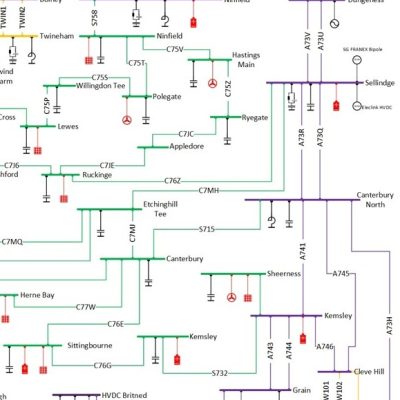Our reseach: impact of renewable energy sources on harmonic levels in the future power grid
Project Overview
The project aims at assessing and forecasting the impact of renewable generation sources (RESs) on harmonic levels within the UK power grid.
As electricity generation moves away from a low number of large-scale power stations to multiple, smaller and more localised RESs, connected to the grid by means of power converters, the levels of harmonics within both transmission and distribution system are increasing.
Harmonics have negative effects on power quality and connected equipment; as such, their management and control has become more pertinent as the growth of RESs continues.

Single-line diagram showing a section of the model used, including a various technologies (wind, solar, batteries)
Background
One of the main changes to the UK power grid in recent years has been the influx of Renewable Energy Sources (RESs), mostly in the form of wind and solar energy. In 2013, 14.9% of the UK electrical generation was from renewable sources; in 2017, this figure had risen to 27.9%, and it will continue to increase, as the Paris Agreement on climate change took effect from 2020 and the UK government will phase out coal-fired electricity generation by 2025.
RESs are connected to the grid by means of voltage source converters (VSCs). One of the side effects of these devices is the increasing level of harmonics injected in the power grid. Harmonics affect the system’s ability to perform at optimal levels by increasing power losses, causing malfunctioning in the equipment, and nuisance tripping. These detrimental effects have an impact on the users of electricity and on the system operators, who invest large amount of resources in studying the impact of RESs on the power grid, developing mitigating solutions, and upgrading equipment when necessary.
This project will investigate the transfer of harmonics between different voltage levels caused by RESs, by creating an innovative model of the UK power grid that includes both transmission and distribution system representation. The impact of increasing levels of RESs on harmonic levels and on system impedance will be addressed and suitable mitigating solutions will be identified. The research will be undertaken in partnership with National Grid, Measurable, and the University of Texas at Austin.
Aims and objectives
The main output of this work will consist of computational models and methodologies to be used by academics and industries involved in performing harmonic assessments, not only in the UK. The models will be developed in close collaboration with National Grid (main industrial partner) and with the University of Texas at Austin (academic partner) to ensure accuracy and validation of the proposed approach. Measurable Energy (second industrial partner) will contribute with data validation and verification of energy measurements.
To achieve these aims, the following objectives have been set:
A comprehensive model that is representative of the UK transmission and distribution system will be developed. While this model cannot fully duplicate the UK power grid, it will be detailed enough to perform a harmonic study. The model effectively integrates and represents different voltage levels, interconnected by means of power transformers.
All RES studied in this project are connected to the grid by means of a voltage-source converters (VSCs), and therefore the models developed to represent each device will have a similar structure. These models will satisfy the requirement of accuracy, while not increasing significantly the simulation time. They will also be scalable so as to represent both single isolated units and largescale connected RES systems.
Different scenarios will be studied and the impact of increasing numbers of RES will be studied by running Monte Carlo simulations. The results will be presented in form of a probability distribution (WP2.2).
Harmonic emission levels for equipment are included in Engineering Recommendation G5/4-1, currently under revision. The harmonic levels obtained in WP2.2 will be compared with the limits included in the most updated version of the standard. Harmonics up to the 100th component will be studied in this work, as these frequencies will be included in the revised standard.
The majority of power meters do not correctly record power measurement under non-sinusoidal conditions, because they have mostly been tested and developed under sinusoidal operating conditions. This objective will show the impact that harmonics will have on power measurement calculated by different devices, and best practices will be identified.
The most commonly adopted mitigating solutions for harmonics consist of passive filters, i.e. tuned LC components. However, with the increasing number of dispersed harmonic sources, passive filters may not be effective anymore as these devices are typically designed to mitigate harmonics due to large loads. Recommendations on the most appropriate mitigating solutions will be provided as a result of this work package.
Publications
For all publications linked to this project click here.